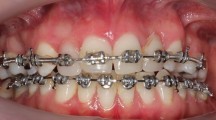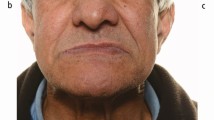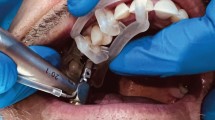Key Points
-
Interdisciplinary therapy involves the combination of diagnostic, treatment planning, and therapeutic procedures amongst different specialties.
-
Allied specialists must be recruited to optimise the peri-implant site prior to placement and restoration.
-
A team approach to the management of patients who require implant dentistry allows more ideal restorations to be developed.
Key Points
Implants
-
1
Rationale for dental implants
-
2
Treatment planning of implants in posterior quadrants
-
3
Treatment planning of implants in the aesthetic zone
-
4
Surgical guidelines for dental implant placement
-
5
Immediate implant placement: treatment planning and surgical steps for successful outcomes
-
6
Treatment planning of the edentulous maxilla
-
7
Treatment planning of the edentulous mandible
-
8
Impressions techniques for implant dentistry
-
9
Screw versus cemented implant supported restorations
-
10
Designing abutments for cement retained implant supported restorations
-
11
Connecting implants to teeth
-
12
Transitioning a patient from teeth to implants
-
13
The role of orthodontics in implant dentistry
-
14
Interdisciplinary approach to implant dentistry
-
15
Factors that affect individual tooth prognosis and choices in contemporary treatment planning
-
16
Maintenance and failures
Abstract
The practice of implant dentistry requires an interdisciplinary approach that integrates the knowledge, skills and experience of all the disciplines of dentistry into a comprehensive treatment plan. This article outlines a comprehensive interdisciplinary treatment philosophy designed for developing the foundation of optimal aesthetics in implant dentistry. Cases are presented to illustrate the utility of interdisciplinary treatment in which specialists are recruited to enhance and improve a patient's dental function and aesthetics.
Similar content being viewed by others
Main
In recent years implant dentistry has been increasingly influenced by aesthetic considerations.1 The primary reason for this is patients' demands for natural-appearing restorations.
The goal of modern implant dentistry is no longer represented solely by successful osseointegration. In order to claim success the definitive restorations must be surrounded by a soft and hard tissue environment in harmony with the existing dentition.2 Talented ceramists can fabricate restorations that mimic the adjacent teeth, however, if reconstruction of the surrounding tissue is not realised, the end result will not be aesthetically pleasing. It remains the responsibility of the implant team to consider all the variables that can influence the final outcome prior to embarking upon treatment.3
With the elevated expectations of patients and increased experience and knowledge of clinicians, there is no doubt that an interdisciplinary approach that integrates the knowledge, skills, and experience of all the disciplines of dentistry into a comprehensive treatment plan can yield better results.
Well executed implant supported restorations can offer exceptional satisfaction to both the patient and dentist. They can transform an unhealthy, unattractive dentition to one which is aesthetically pleasing to the patient. In addition implant supported restorations can improve comfort and function. The longevity of implants is well documented, and in many situations where posterior support is lacking, implant supported restorations are the only method of predictably providing this support for occlusion in the long term.
To obtain optimal results meticulous attention must be paid to myriad details. The process starts with the patient interview and meticulous treatment planning, then continues through to active treatment and culminates in regular planned follow-up care.
The objectives are to improve oral health, to establish proper occlusal function and to create the most ideal aesthetic result possible. It is only through an organised and systematic approach that appropriate diagnoses can be made. Based on these diagnoses, functional and aesthetic problems can be addressed predictably.
Interdisciplinary therapy involves the combination of diagnostic, treatment planning, and therapeutic procedures. It is imperative that the team leader appropriately selects a team of practitioners. The selection process can either have a positive or a negative impact on the overall treatment. Each provider on the team must have an optimal level of skill in his or her area of expertise to be a positive factor.4
The complex nature of dentofacial problems necessitates a highly organised method of communication between the team members so that all aspects of treatment can be equally voiced. It is through this communication that an interdisciplinary treatment plan can be formulated prior to generation of a joint treatment letter. This treatment letter should include a discussion of aspects of treatment that will be provided by each team member, time frame of the proposed treatment, inherent risks involved, informed consent and financial responsibilities of the patient. It can be said that the quality of treatment is dependent upon the quality of the communication. It is critical that the team leader maintains communication between the specialists both during treatment and once it has been completed. It is only through this approach that optimal care can be delivered and regular planned follow up care can be implemented.
The purpose of this article is to outline the blueprint for a comprehensive interdisciplinary treatment philosophy, designed for developing the foundation for optimal aesthetics in implant dentistry. Some cases will be presented to illustrate the utility of interdisciplinary treatment where allied specialists are recruited to enhance and improve the existing presentations of the patients both for function and aesthetics.
Case 1
This 36-year-old male was seeking replacement of his current removable partial denture with fixed restorations. His specific complaint was the instability and aesthetics of the removable restorations (Figs 1, 2, 3, 4).
On clinical and radiographic examination a couple of problems presented. Periodontally the molars on the maxillary left hand side were deemed to have a poor prognosis. The mandibular molars were tilted mesially and there was insufficient space between the posterior teeth to provide the patient with fixed partial dentures that would satisfy his aesthetic requirements (Figs 5, 6, 7, 8).
The objectives of treatment included creating space between the posterior teeth so that implant supported restorations could be provided, extracting teeth which were deemed to have poor prognosis and to provide restorations for the patient that would fulfill his aesthetic and functional desires.
Orthodontics can serve as a valuable adjunct to treatment planning in restorative dentistry. When significant numbers of teeth are missing the implants can also be used to effect the desired tooth movement. The literature has shown that dental implants can be used as anchors for both orthodontic and orthopaedic movement.5,6,7 It can also serve to create space between teeth so that implants can be placed.
With these objectives in mind a treatment plan was formulated which required communication between the surgeon, orthodontist and prosthodontist.
The first stage was to complete extraction of mandibular third molars and maxillary molars on the upper left hand side.
An orthodontic set up was completed on the cast to determine the post-orthodontic position of the teeth (Figs 9, 10, 11, 12, 13). This set up was used to communicate the ideal tooth positions required to the orthodontist. Sufficient space would be required to allow the implants to be placed at least 1.5 mm away from the roots of the adjacent teeth and to allow appropriate coronal space for aesthetic contouring of the restorations. Brackets were placed and the appropriate tooth movements were made (Figs 14, 15, 16, 17). During the orthodontic phase a sinus lift was performed in the maxillary left area and bone was harvested from the chin for augmentation.
Once the appropriate tooth positions had been achieved impressions were made for casts on which a diagnostic wax up was completed. This diagnostic wax up was used to fabricate provisional restorations which would be used to stabilise the post-orthodontic position of the teeth. These restorations also improved aesthetics, provided posterior vertical support and served as blueprints for the definitive implant borne restorations (Figs 18, 19, 20, 21).9 Once the patient accepted the aesthetics of the provisional restorations these were duplicated to provide surgical guides for implant placement and implants were placed taking care to position them appropriately from the adjacent teeth (Fig. 22).
Following osseointegration a second set of provisionals were provided to re-confirm the patient's acceptance of aesthetics and function. The upper right canine and lateral incisor were prepared for metal ceramic restorations and a final impression was made for the definitive prosthesis. All final restorations were planned as single units except for the maxillary left area where the premolars were cemented due to implant angulations and the molars were splinted to improve biomechanical outcomes (Figs 23, 24, 25, 26, 27, 28, 29, 30, 31).
Communication between the allied specialists is essential to achieve optimal results. Without adequate communication, the treatment provided irregardless of the initial planning will fall short of the desired results. A systematic planned and executed treatment protocol will meet the desired goals and inevitably will result in a satisfied patient.
Case 2
A 28-year-old female presented with congenitally missing lateral incisors. These edentulous spaces had been restored previously with resin bonded fixed partial dentures which had not provided a successful outcome. The patient also felt that the maxillary central incisors were narrow and requested a more dominant appearance (Fig. 32).
Clinical and radiographic examination indicated a number of issues which could be corrected to improve the overall aesthetics. These included, relative tooth dimensions, prosthetic replacement of the lateral incisors, colour and smile symmetry.10 To confirm that the analysis matched the perceptions of the patient a diagnostic wax pattern was formed and an acrylic resin template of the wax pattern fabricated. This template served to communicate the desired result to the patient. Approval from the patient was sought and obtained and then the treatment plan was formulated and put into action.
Radiographic examination also revealed inadequate inter-radicular space for placement of the implants without damaging the adjacent teeth, and computer aided tomography (CT) revealed inadequate bucco-lingual osseous dimensions for insertion of implants (Figs 33, 34).
A treatment plan was formulated which included communication between the orthodontist, surgeon and prosthodontist. The first phase of treatment included orthodontic therapy to provide a sufficient inter-radicular space for placement of implants. It was communicated to the patient that following orthodontic therapy the incisal edges of teeth numbers 8 and 9 would be irregular and as a result would require restoration (Fig. 35).
Following orthodontic therapy an autogenous bone graft was performed to restore the osseous volume in the regions of teeth numbers 7 and 10. Bone was harvested from the mandibular symphysis (Figs 36, 37).
To attain the optimal morphology of the prosthetic restorations accurate three dimensional positioning of the implant fixtures is critical. A diagnostic wax up was completed and used to fabricate a surgical template which served to communicate the implant position to the surgeon. The mesio-distal positioning of the implant required at least 1.5 mm of clearance from the adjacent teeth. This clearance was necessary to develop and maintain the integrity of the papilla.11 Bucco-lingually the implants were placed for screw retained restorations with the screw access holes emerging from the cingulum of the definitive restorations. Apico-coronally the fixtures were placed 2 mm apical to the adjacent CEJ; this allowed for adequate transition from the cross section of the implant to the natural contours of the replacement tooth. An implant level impression was obtained immediately after implant insertion. This impression was used to fabricate provisional restorations which were delivered after uncovering the implant (at stage II) to develop appropriate soft tissue contours.12
After preparation of the maxillary central incisors for porcelain veneers, the implant provisional restorations were used as impression copings and incorporated into the impression (Fig. 38). A soft tissue cast was poured against the provisional restoration to provide a good replication of soft tissue (Fig. 39). Provisional restorations were provided for the patient (Fig. 40) and definitive restorations were fabricated (Figs 41, 42, 43).
The definitive restorations satisfied the functional and aesthetic goal of treatment. This was a result of coordinated efforts between the surgeon, orthodontist, prosthodontist and laboratory technician. Restoration of tooth position and optimal bone volume were essential to ensure that only minor adjustments were required at the time of implant placement. Careful observation of the chronology of treatment stages and constant communication between the allied specialists ensured an optimal aesthetic and functional outcome.
Case 3
This 34-year-old female presented with the desire to have implant therapy for her missing lower right second premolar. This particular tooth had been extracted 10 years previously. Clinical examination revealed mesial drift of the first molar (Fig. 44). There was also inadequate bucco-lingual bone for ideal placement of an implant (Fig. 45). The patient was made aware of the complex nature of the therapy and on approval, an interdisciplinary approach was initiated. The first and second molars were orthodontically up-righted (Fig. 46) until sufficient mesiodistal space was created to allow fabrication of a restoration which mimicked the dimensions of the contra lateral side. Following up-righting, autogenous bone was harvested from the mandibular symphysis to augment bucco-lingual width so that an implant could be placed (Fig. 47). Following healing a surgical guide was fabricated to allow implant placement in the ideal position. The implant was subsequently placed and restored to ideal form and function (Fig. 48).
This interdisciplinary treatment allowed the patient to have implants placed and conserve the adjacent teeth. Without communication between the specialties this type of treatment would not have been possible.
Summary
This article illustrates the advantages of an interdisciplinary approach to the management of patients who require implant dentistry. Treatment planning must begin through visualisation of the end result. By paying attention to details and systematically analysing each factor that affects the aesthetic result, recognising inadequacies in osseous and gingival contour, the restorative dentist can take advantage of the benefits of orthodontic and periodontal treatment to enhance the aesthetic and functional outcomes. Without an interdisciplinary approach final outcomes can be compromised. With a team approach to the management of patients who require implant dentistry treatment fewer compromises will occur and more ideal restorations can be developed.
References
Rufenacht C R. Fundamentals of esthetics. Chicago, IL: Quintessence Publishing, 1990.
Phillips K, Kois J C. Aesthetic peri-implant site development. The restorative connection. Dent Clin North Am 1998; 42: 57–70.
Schincaglia G P, Nowzari H. Surgical treatment planning for the single-unit implant in aesthetic areas. Periodontology 2000 2001; 27: 162–182.
Roblee R D. Interdisciplinary dentofacial therapy. A comprehensive approach to optimal patient care. pp 17–43. Chicago, IL: Quintessence Publishing, 1994.
Smalley W M, Shapiro P A, Hohl T H, Kokich V G, Branemark P I. Osseointegrated titanium implants for maxillofacial protraction in monkeys. Am J Orthod Dentofac Orthop 1988; 94: 285–295.
Douglas J, Killinay D. Dental implants used as orthodontic anchorage. J Oral Implantol 1988; 13: 28–38.
Kokitch V. Managing complex orthodontic problems. The use of implants for anchorage. Semin Orthodont 1996; 2: 153–160.
Smalley W M. Implants for tooth movement: determining implant location and orientation. J Esthet Dent 1995; 7: 62–72.
Smalley W M. Implants for tooth movement: a fabrication and placement technique for provisional restorations. J Esthet Dent 1995; 7: 150–154.
Magne P, Belser U. Bonded porcelain restorations in the anterior dentition. A biomimetic approach. pp 57–99. Chicago, IL: Quintessence Publishing, 2002.
Jansen C, Weisgold A. Presurgical treatment planning for the anterior single tooth implant restoration. Compend Cont Educ Dent 1995; 16: 746–762.
Hochwald D A. Surgical template impression during stage one surgery for fabrication of a provisional restoration to be placed at stage two surgery. J Prosthet Dent 1991; 66: 796–798.
Acknowledgements
The authors would like to thank the Journal of the California Dental Association for permission to reprint parts of this article which were initially published in the JCDA April 2005 issue. The authors would also like to thank the advanced periodontology department at the University of Southern California for placement of implants in cases 1, 2 and 3.
Author information
Authors and Affiliations
Corresponding author
Additional information
Refereed Paper
Rights and permissions
About this article
Cite this article
Jivraj, S., Corrado, P. & Chee, W. An interdisciplinary approach to treatment planning in implant dentistry. Br Dent J 202, 11–17 (2007). https://doi.org/10.1038/bdj.2006.106
Published:
Issue Date:
DOI: https://doi.org/10.1038/bdj.2006.106



















































